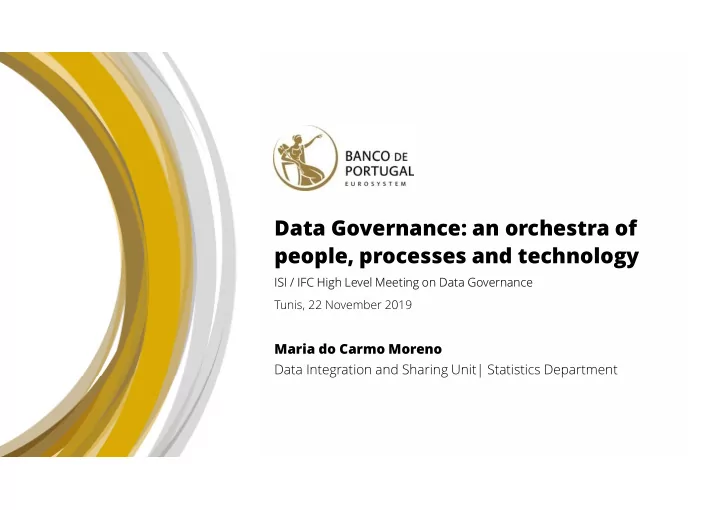

Data Governance: an orchestra of people, processes and technology ISI / IFC High Level Meeting on Data Governance Tunis, 22 November 2019 Maria do Carmo Moreno Data Integration and Sharing Unit| Statistics Department 1
Information is a major asset THE NEW DATA LANDSCAPE OF THE NCBs deal with massive amounts of data and a large share of POST-CRISIS HAS these data is managed by Statistics Departments PERMEATED Projects involving microdata and big data are more frequent CENTRAL BANKS IN Integrated reporting schemes addressing multiple purposes within the MANY WAYS central bank are already in place and will continue to be developed New data architectures are being implemented to address the need to: Combine data from multiple datasets Promote data-sharing throughout the institution Allow the regular data exploration and also experimental analysis Increase the usefulness of the data available not only to the internal users but also, e.g., to the research community However, data integration is still a challenge: Data integration requires more than a technical evolution: there is the need for a cultural change in the organization which has to be supported by a strong governance model . 2
In 2017 Banco de Portugal launched the INTEGRATED DATA MANAGEMENT (IDM) programme The IDM is a major transformational initiative of the Strategic Plan 2017-2020. The IDM is jointly coordinated by 2 departments: The goal of the IDM is to strongly contribute to a better use of the available data in the Bank by means of rationalisation of the processes IT associated with its collection and processing and to promote its effective sharing throughout STATISTICS the whole organisation. 3
The level of understanding of the programme by the Strong various departments is sponsorship not homogeneous. from the Adequate expectations Board management is vital SUCCESS FACTORS Pursuing the Dedicated teams FOR THE global vision (both in Statistics supported by and IT ) iterative IMPLEMENTATION objectives OF THE IDM All departments THE MAJOR CHANGE must recognize Setting an themselves in the INDUCED BY THE IDM IS NOT enterprise-wide programme and TECHNOLOGICAL BUT DATA GOVERNANCE should be involved CULTURAL/ORGANISATIONAL in the decisions 4
THE GOVERNANCE MODEL Centralized coordination with decentralized roles and responsibilities across the organisation DECISION MAKING [Board] STRATEGIC COORDINATION [Information and Technology Management Committee] Information security OPERATIONAL COORDINATION Risk Information technologies management Data management [IT Department] [Statistics Department] Data DEPARTMENTS protection Data providers Data stewards Data owners System owners Audit Data users Data experts Data managers Data custodians (IT Dep.) 5
Who is who in the Governance Model DATA EXPERTS SYSTEM OWNER DATA OWNER DATA STEWARD Business specialists Employees appointed by Department responsible for the Directors of each responsible for Departments managing the content department to be the launching the responsible for a set of of their area of prime point of contact development of an information within the in their business area, expertise - whether corporate Data information system and promoting the business data, Warehouse typically the main user implementation of the reference data or of that system IDM Programme. catalogue information Data management is a shared responsibility implying individual (business areas) commitment in contributing to the overall data quality 6
THE LOGICAL DATA ARCHITECTURE DATA SOURCES INTEGRATION & STORAGE EXPLORATION DATA SCIENCE DATA LAKE MASTER DATA CORPORATE DATA WAREHOUSE SECURITY, ADMINISTRATION AND MONITORING DATA CATALOGUE 7
CONCLUDING Central banks today have incredible amounts of data to support their different REMARKS missions. DG ensures these data are trusted, well-documented, and easy to find and access within the whole organization, and that it is kept secure, compliant, and confidential – DG is not optional! Effective DG encompasses the right levels of policies and procedures , structures , and roles and responsibilities Besides clear decision making, a successful DG strategy implies a solid partnership between business and technology and combining the use of top-down and bottom- up approaches DG policies will lose their value if they’re not followed in day-to-day operations across the organization. Data stewardship (in all business areas) is now looked as a critical function for the success of the DG Data governance brings the human dimension into a highly automated, data- driven world 8
Recommend
More recommend